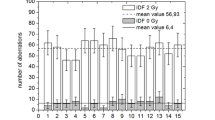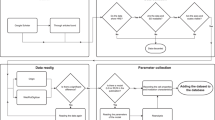Abstract
A correlation between the effectiveness of the radioprotective action of cysteamine with the radiosensitivity of cells and their ability to recover from radiation damage was demonstrated for diploid yeast cells of S. cerevisiae. To demonstrate the involvement of the recovery processes in the mechanism for radioprotective action of the T1023 compound in animals, data on the survival of clonogenic bone marrow cells of mice exposed to ionizing radiation are presented. It is shown that the radioprotective effect of this compound can be realized not only at the physicochemical stage of formation of radiation damage due to a decrease in the oxygen content in tissues but also due to the post-radiation cell recovery at the biochemical stage. This is confirmed by the presence of the sigmoid part of the dose-response curve in the region of low doses of ionizing radiation.



Similar content being viewed by others
REFERENCES
Bresler, S.E., Noskin, L.A., Stepanova, I.M., et al., Mechanisms of the radioprotecting action of chemical compounds of Escherichia coli cells, Mol. Gen. Genet., 1978, vol. 163, no. 1, pp. 75–85.
Noskin, L.A., Molecular mechanisms of reparative balance in pro- and eukaryotic cells, Doctoral (Biol.) Dissertation, Gatchina, 1984.
Rozhdestvenskii, L.M., Oxygen effect and repair processes, in Mekhanizmy luchevoi patologii. Sbornik (Mechanisms of Radiation Pathology: Collection of Papers), Kudryashov, Yu.B., Ed., Moscow: Mosk. Univ., 1984, pp. 119–127.
Rozhdestvenskii, L.M., Mekhanizm radiozashchitnogo effekta i indikatsiya effektivnosti radioprotektorov (The Mechanism of the Radioprotective Effect and Indication of the Effectiveness of Radioprotectors), Moscow: Energoatmoizdat, 1985.
Eidus, L.Kh., General scheme of modifications of radiation cell damage, in Mekhanizmy luchevoi patologii. Sbornik (Mechanisms of Radiation Pathology: Collection of Papers), Kudryashov, Yu.B., Ed., Moscow: Mosk. Univ., 1984.
Eidus, L.Kh. and Korystov, Yu.N., Kislorod v radiobiologii (Oxygen in Radiobiology), Moscow: Energoatomizdat, 1984.
Korogodin, V.I., Problemy postradiatsionnogo vosstanovleniya (Problems of Postradiation Recovery), Moscow: Atomizdat, 1966.
Gil’yano, N.Ya., Malinovskii, O.V., and Kharlamov, A.D., Radioprotective effect of cysteamine on yeast cells of wild-type and repair-mutant strains, Radiobiologiya, 1981, vol. 21, no. 3, pp. 379–383.
Filimonova, M.V., Shevchenko, L.I., Makarchuk, V.M., et al., Radioprotective properties of NO-synthase inhibitor T1023: I. Indicators of radioprotective activity and interaction with other radioprotectors, Radiats. Biol. Radioekol., 2015, vol. 55, no. 3, pp. 250–259.
Petin, V.G. and Kim, J.K., Synergistic Interaction and Cell Responses to Environmental Factors, New York: Nova Science Publishers, 2016.
Yarmonenko, S.P., Konoplyannikov, A.G., and Vainson, A.A., Klinicheskaya radiobiologiya (Clinical Radiobiology), Moscow: Meditsina, 1992.
Hall, E.J., Radiobiology for the Radiologist, Philadelphia: Lippincott Williams and Wilkins, 2000.
Neklyudov, A.G., Komarov, V.P., and Petin, V.G., A quantitative description of the modification of radiosensitivity, Radiobiologiya, 1987, vol. 27, no. 1, pp. 46–51.
Revesz, L., Edgren, M., and Nishida, T., Mechanisms of inherent radioprotection in mammalian cells, in Modification and Radiosensitivity in Cancer Treatment, Sugahara, T., Ed., Tokyo: Academic, 1984, pp. 13–29.
Avdeeva, L.V., Evstyukhina, T.A., Kol’tover, V.K., et al., Magnetic isotopes: a new approach to the creation of new antiradiation agents, in Materialy Mezhdunarodnoi konferentsii “Problemy khimicheskoi zashchity i reparatsii pri radiatsionnykh vozdeistviyakh” (Dubna, 30–31 maya 2018 g.) (Proc. Int. Conf. “Problems of Chemical Protection and repair in Case of Radiation Exposure” (Dubna, May 30–31, 2018)), Dubna, 2018, pp. 78–80.
Funding
This publication was prepared with the support of the Russian President’s grant MK-872.2018.4 (Agreement no. 075-02-2018-570), as well as within the scientific project of the Russian Foundation for Basic Research and the Kaluga Region Government no. 18-413-400004a(p).
Author information
Authors and Affiliations
Corresponding author
Ethics declarations
The authors declare that they have no conflict of interest. This article does not contain any studies involving animals or human participants performed by any of the authors.
Additional information
Translated by M. Batrukova
Rights and permissions
About this article
Cite this article
Filimonova, M.V., Evstratova, E.S., Makarchuk, V.M. et al. Involvement of Recovery Processes in the Effects of Radioprotectors at the Cellular and Organismal Levels. Biol Bull Russ Acad Sci 46, 1619–1624 (2019). https://doi.org/10.1134/S1062359019120033
Received:
Published:
Issue Date:
DOI: https://doi.org/10.1134/S1062359019120033




